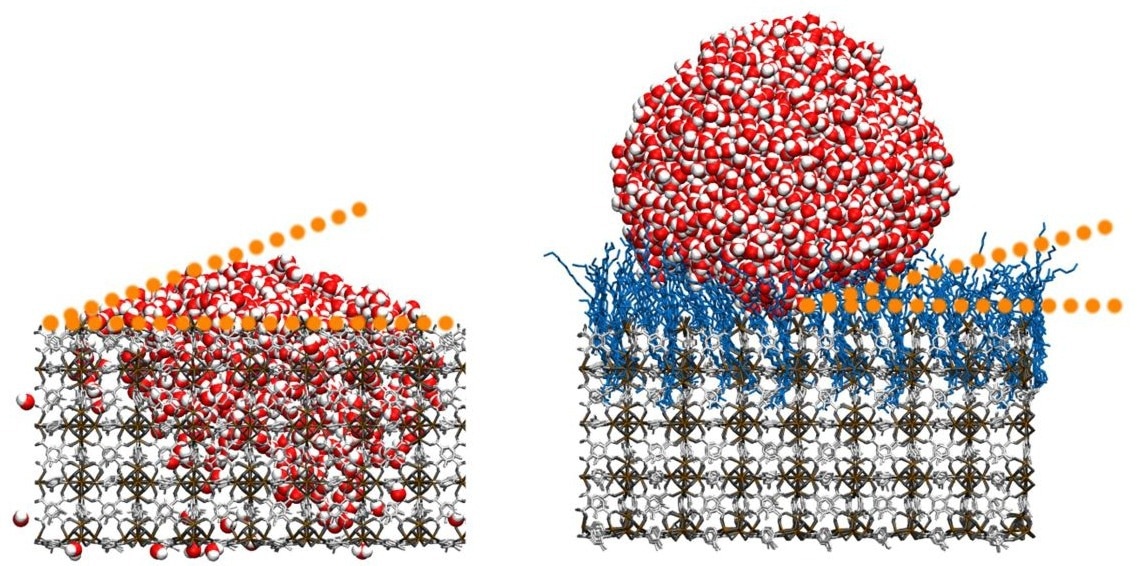Scientists from Karlsruhe Institute of Technology (KIT) and the Indian Institute of Technology Guwahati (IITG) have developed a surface material that repels water droplets almost entirely.
 Left: Porous substrate with a small water contact angle: The surface absorbs a lot of liquid. Right: The new material features a large water contact angle and is thus nearly completely hydrophobic. Image Credit: KIT
Left: Porous substrate with a small water contact angle: The surface absorbs a lot of liquid. Right: The new material features a large water contact angle and is thus nearly completely hydrophobic. Image Credit: KIT
The breakthrough comes from a novel process that modifies metal-organic frameworks (MOFs)—materials engineered with unique properties—by attaching hydrocarbon chains. The result is a superhydrophobic surface, highly resistant to water, making it ideal for self-cleaning applications that need to withstand environmental factors, such as those found in automobiles or architecture.
MOFs are composed of metal ions and organic linkers that create a network of porous structures, similar to a sponge. Their remarkable volumetric properties—where two grams of the material can unfold to cover the area of a football pitch—make them highly attractive for applications like gas storage, carbon dioxide separation, and emerging medical technologies.
The outer surfaces of these crystalline materials also exhibit unique characteristics. The research team leveraged this by grafting hydrocarbon chains onto thin MOF films. They observed a water contact angle of over 160 degrees—the greater the angle formed between the surface of a water droplet and the substrate, the better the hydrophobic properties of the material.
With our method, we are able to achieve superhydrophobic surfaces with contact angles that are significantly higher than those of other smooth surfaces and coatings. Although the wetting properties of MOF powder particles have been explored before, the use of monolithic MOF thin films for this purpose is a groundbreaking concept.
Christof Wöll, Professor, Institute of Functional Interfaces, Karlsruhe Institute of Technology
Next-Generation “Superhydrophobic” Materials
The team credits the success of this process to the polymer brush-like arrangement of the hydrocarbon chains on the MOFs. Once grafted onto the MOF films, these chains form a disordered "coil" structure, known as a "high-entropy state," which is key to the material's hydrophobic properties. The scientists noted that this high-entropy state is unique to the MOFs and cannot be achieved with other materials.
Interestingly, the use of perfluorinated hydrocarbon chains—which typically enhance superhydrophobic properties in materials like Teflon—had the opposite effect. Instead of improving the material’s water-repelling abilities, it significantly reduced the water contact angle. Computer simulations confirmed that perfluorinated molecules were unable to reach the energetically favorable high-entropy state that was achieved with the hydrocarbon chains.
Additionally, the team experimented with the surface roughness of their SAM@SURMOF systems at the nanometer scale, further reducing water adhesion. Even at very small angles, water droplets began to roll off, and the material's self-cleaning properties were greatly enhanced.
Our work also includes a detailed theoretical analysis, which links the unexpected behavior shown in experiments to the high-entropy state of the molecules grafted to the MOF films. This study will change the design and production of next-generation materials with optimum hydrophobic properties.
Uttam Manna, Professor, Chemistry Department, Indian Institute of Technology Guwahati
Journal Reference:
Bogdanova, E., et. al. (2024) Functionalization of monolithic MOF thin films with hydrocarbon chains to achieve superhydrophobic surfaces with tunable water adhesion strength. Materials Horizons. doi.org/10.1039/D4MH00899E